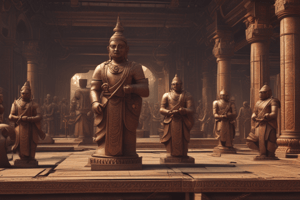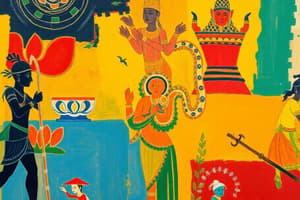Podcast
Questions and Answers
Iron tools included axes for clearing forests and what other tool?
Iron tools included axes for clearing forests and what other tool?
- Iron ploughshare (correct)
- Sickle
- Axe
- Tongs
Name some irrigation works that were built around 2500 years ago.
Name some irrigation works that were built around 2500 years ago.
Canals, wells, tanks and artificial lakes.
In the Tamil region, what were ordinary ploughmen known as?
In the Tamil region, what were ordinary ploughmen known as?
- Vellalar
- Uzhavar (correct)
- Kadaisiyar
- Grama bhojaka
In the northern part of the country, what was the village headman known as?
In the northern part of the country, what was the village headman known as?
What items were punch-marked coins stamped with?
What items were punch-marked coins stamped with?
What was Mathura an important center for?
What was Mathura an important center for?
What does NBPW stand for?
What does NBPW stand for?
According to the Arthashastra, who may be used for processing wool, bark, cotton, hemp and flax?
According to the Arthashastra, who may be used for processing wool, bark, cotton, hemp and flax?
What is the name of the associations that many craftspersons and merchants formed?
What is the name of the associations that many craftspersons and merchants formed?
What items were imported into Barygaza?
What items were imported into Barygaza?
What items were exported from Barygaza?
What items were exported from Barygaza?
South India was not known for spices.
South India was not known for spices.
Which of these dynasties became powerful in western India around 200 years later?
Which of these dynasties became powerful in western India around 200 years later?
What is 'muvendar'?
What is 'muvendar'?
The best-known of the rulers who controlled the Silk Route were who?
The best-known of the rulers who controlled the Silk Route were who?
Flashcards
Iron Tools in Agriculture
Iron Tools in Agriculture
Tools like axes and sickles made of iron, crucial for clearing forests and increasing agricultural production around 2500 years ago.
Irrigation
Irrigation
Artificial methods of supplying water to land, including canals, wells, tanks, and lakes, that aided increased agricultural output.
Vellalar
Vellalar
Large landowners in the Tamil region.
Uzhavar
Uzhavar
Signup and view all the flashcards
Kadaisiyar and Adimai
Kadaisiyar and Adimai
Signup and view all the flashcards
Grama Bhojaka
Grama Bhojaka
Signup and view all the flashcards
Grihapatis
Grihapatis
Signup and view all the flashcards
Dasa Karmakara
Dasa Karmakara
Signup and view all the flashcards
Sangam Literature
Sangam Literature
Signup and view all the flashcards
Punch-Marked Coins
Punch-Marked Coins
Signup and view all the flashcards
Mathura
Mathura
Signup and view all the flashcards
Northern Black Polished Ware (NBPW)
Northern Black Polished Ware (NBPW)
Signup and view all the flashcards
Shrenis
Shrenis
Signup and view all the flashcards
Arikamedu
Arikamedu
Signup and view all the flashcards
Amphorae
Amphorae
Signup and view all the flashcards
Arretine Ware
Arretine Ware
Signup and view all the flashcards
Gold, Spices & Precious Stones
Gold, Spices & Precious Stones
Signup and view all the flashcards
Muvendar
Muvendar
Signup and view all the flashcards
Puhar (Kaveripattinam)
Puhar (Kaveripattinam)
Signup and view all the flashcards
Madurai
Madurai
Signup and view all the flashcards
Satavahanas
Satavahanas
Signup and view all the flashcards
Dakshinapatha
Dakshinapatha
Signup and view all the flashcards
Kushanas
Kushanas
Signup and view all the flashcards
Peshawar and Mathura
Peshawar and Mathura
Signup and view all the flashcards
Vellalar Definition
Vellalar Definition
Signup and view all the flashcards
Uzhavar Definition
Uzhavar Definition
Signup and view all the flashcards
Kadaisiyar/Adimai Definition
Kadaisiyar/Adimai Definition
Signup and view all the flashcards
Grama Bhojaka Definition
Grama Bhojaka Definition
Signup and view all the flashcards
Grihapatis Definition
Grihapatis Definition
Signup and view all the flashcards
Dasa Karmakara Definition
Dasa Karmakara Definition
Signup and view all the flashcards
Study Notes
- Chapter 8 discusses villages, towns, and trade in ancient times; it focuses on the use of iron tools, agriculture, irrigation, village life, coinage, cities, and trade routes.
Iron Tools and Agriculture
- Iron use is taken for granted today, but it became common in the subcontinent around 3000 years ago.
- Large collections of iron tools and weapons have been found in megalithic burials.
- Around 2500 years ago, iron tools like axes and ploughshares increased agricultural production via forest clearing.
- Irrigation, including canals, wells, tanks, and artificial lakes, augmented new tools and transplantation to boost production.
Village Life
- Kings and kingdoms relied on flourishing villages for support.
- Southern and northern India had at least three types of people in villages.
- Vellalar: large landowners in the Tamil region.
- Uzhavar: ordinary ploughmen.
- Kadaisiyar and adimai: landless laborers, including slaves.
- The village headman in the northern part of the country was known as the grama bhojaka; the position was hereditary, held by the same family for generations.
- The grama bhojaka was often the largest landowner who used slaves and hired workers for cultivation; the king used the grama bhojaka to collect taxes and as a judge or policeman.
- Independent farmers known as grihapatis were usually smaller landowners.
- Dasa karmakara were men and women who did not own land and earned a living by working on others' fields.
- Villages also had blacksmiths, potters, carpenters, and weavers.
- The Sangam literature is made up of some of the earliest Tamil works that were composed around 2300 years ago; the texts were composed and compiled in assemblies of poets in Madurai.
Coins and Exchange
- Archaeologists have found thousands of coins from this period.
- The earliest coins, used for about 500 years, were punch-marked coins.
- Punch-marked coins were generally rectangular, square, or round, either cut from metal sheets or made of flattened metal globules, stamped with symbols using dies or punches.
- Other means of transactions included bartering.
Cities
- Mathura, an important settlement for over 2500 years, was at the crossroads of major travel and trade routes.
- The city had fortifications, shrines, Buddhist monasteries, Jaina shrines, and was a center for Krishna worship.
- Inscriptions on stone slabs and statues in Mathura record gifts to monasteries and shrines by kings, queens, officers, merchants, and craftspersons, including goldsmiths, blacksmiths, weavers, basket makers garland makers, and perfumers.
- Mathura became the second capital of the Kushanas around 2000 years ago.
- Archaeological finds show evidence for crafts like the Northern Black Polished Ware (NBPW), extremely fine pottery found in the northern subcontinent; cloth manufacture was also important.
- Trade centers for textiles included Varanasi in the north and Madurai in the south, where both men and women worked.
Shrenis
- Craftspersons and merchants formed associations known as shrenis.
- Shrenis provided training, raw materials, and distributed finished products; merchant shrenis organized trade.
- Shrenis also functioned as banks, accepting deposits and using the money for investments or to support religious institutions like monasteries.
Arikamedu
- Arikamedu, a coastal settlement (modern Puducherry), existed between 2200 and 1900 years ago, serving as a port for unloading goods from distant lands.
- A massive brick structure that may have been a warehouse existed there.
- Pottery from the Mediterranean region, like amphorae and Arretine Ware, has been found at the site.
- Arretine Ware was stamped red-glazed pottery made by pressing wet clay into a mold.
- Other finds: locally made Roman-designed pottery, Roman lamps, glassware, gems, dyeing vats, and evidence for bead making.
- Tamil-Brahmi inscriptions have also been discovered on pottery shards .
Trade
- Imports into Barygaza included wine, copper, tin, lead, coral, topaz, cloth, gold and silver coins.
- Exports from Barygaza included plants from the Himalayas, ivory, agate, carnelian, cotton, silk, and perfumes.
- South India was renowned for gold, spices (especially pepper which was valued in the Roman Empire as "black gold"), and precious stones.
- Traders transported goods to Rome by sea and land via caravans.
- Many Roman gold coins have been discovered in South India, suggesting significant trade activity.
- Trade is described in the Sangam poems that transported goods to Puhar, a port city on the east coast, that included horses, black pepper, gems/gold, sandalwood, pearls, corals, crops from the Ganga/Kaveri, foodstuffs from Sri Lanka, and pottery from Myanmar.
Kingdoms along the Coasts
- Traders explored sea routes along the coasts and across the Arabian Sea and the Bay of Bengal, using monsoon winds.
- The southern subcontinent, marked by a long coastline, hills, plateaus, and river valleys, had the fertile Kaveri River valley.
- Chiefs and kings controlled the river valleys and coasts; they were called muvendar, a Tamil word for the three chiefs as heads of three ruling families.
- The families were the Cholas, Cheras, and Pandyas who became powerful around 2300 years ago.
- Each chief had two centers of power including one inland and one coastal; Puhar (Kaveripattinam), the Chola port, and Madurai, the Pandya capital, were important cities.
- The chiefs did not collect regular taxes but received gifts from the people, conducted military expeditions, and collected tribute from neighboring areas.
- They distributed wealth among family, soldiers, and poets, who in turn wrote poems in praise of the chiefs.
- Chiefs were rewarded with precious stones, gold, horses, elephants, chariots, and fine cloth.
- Approximately 200 years later, the Satavahanas became powerful in western India; Gautamiputra Shri Satakarni was one of the most important rulers.
- Satavahana rulers were known as lords of the dakshinapatha/route leading to the south. The rulers sent their army to the eastern, western, and southern coasts.
Silk Route and the Kushanas
- Some kings tried to control portions of the Silk Route to benefit from taxes, tributes, and gifts.
- The rulers protected traders crossing kingdoms from robber attacks.
- The Kushanas, ruling over central Asia and north-west India around 2000 years ago, were best known for controlling the Silk Route.
- Their major power centers were Peshawar and Mathura.
- During their rule, a Silk Route branch extended from Central Asia to seaports at the mouth of the river Indus, enabling silk to be shipped westwards to the Roman Empire.
Studying That Suits You
Use AI to generate personalized quizzes and flashcards to suit your learning preferences.




